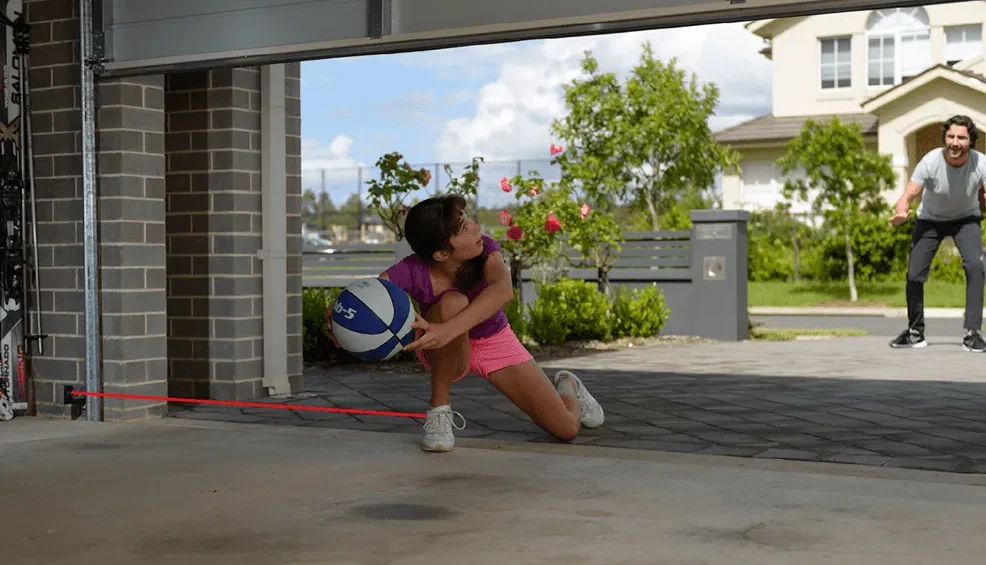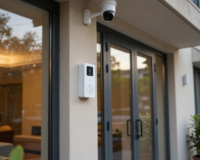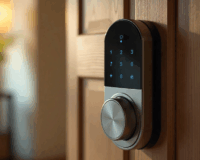In recent years, both residential and commercial garage doors have seen significant technological advancements. Among these innovations, safety sensors stand out for their critical role in preventing accidents and damage by detecting obstructions in the path of a closing door. This article offers an in-depth guide on the ideal installation height and maintenance of garage door safety sensors, particularly for garage door services in Australia.
Read more: Automated Garage Doors: The Ultimate Guide
What is a Garage Door Safety Sensor?
Garage door safety sensors, often referred to as photoelectric sensors, are small devices installed on either side of the garage door, typically near the floor. These sensors emit an invisible beam of light across the width of the garage door opening. When the door is closing, if anything interrupts this beam, the sensors send a signal to the garage door opener to stop and reverse the door’s movement. This safety feature is particularly important for preventing accidents and injuries.
Read more: Garage Gate Motors: The Backbone of Modern Garage Door Systems
The Ideal Height for Garage Door Safety Sensors
The optimal height for installing garage door safety sensors is six inches above the floor. This standard ensures that the sensors can detect low-lying objects, small children, or pets that might be in the door’s path. If the sensors are installed too high, they might miss these obstructions, potentially causing the door to continue closing, leading to injuries or damages.
Importance of Safety Sensor Height
The effectiveness of safety sensors heavily depends on their installation height. Sensors installed at the correct height will accurately detect any obstruction, thus preventing the door from closing on a person, pet, or object. On the other hand, sensors installed too high might not detect low-lying obstacles, increasing the risk of accidents.
Factors to Consider When Installing Garage Door Sensors
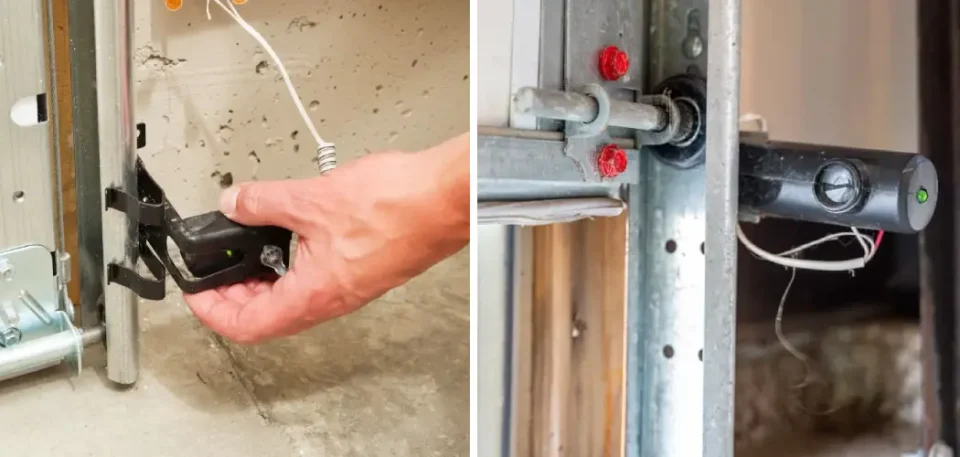
Several key factors must be considered during the installation of garage door safety sensors to ensure their proper functionality:
- Alignment: Sensors must be installed at the same height and aimed directly at each other. Proper alignment ensures that the infrared beams from the transmitter can reach the receiver without interruption.
- Wiring: Sensors are connected to the garage door opener via wires. These wires should be regularly checked for any signs of damage, as damaged wires can affect the sensors’ performance.
- Testing: Regular testing of the sensors is crucial. This can be done by placing an object in the door’s path while it is closing. If the door does not stop and reverse, the sensors may need adjustment or repair.
Importance of Regular Maintenance
Regular maintenance of garage door safety sensors is essential for several reasons:
- Safety: The primary function of these sensors is to prevent accidents. Faulty sensors can lead to dangerous situations where the door might close on a person, pet, or object.
- Longevity: Proper maintenance can extend the lifespan of the sensors, saving money on replacements and repairs.
- Reliability: Well-maintained sensors ensure the garage door operates smoothly and reliably, reducing the chances of inconvenient malfunctions.
- Compliance: Many regions have safety regulations requiring functional garage door sensors. Regular maintenance helps ensure compliance with these laws.
Safety Precautions in Sensor Installation
Safety should always be a top priority when installing garage door sensors. Here are some important precautions:
- Follow Instructions: Always adhere to the manufacturer’s instructions during installation. This ensures that all necessary tools are used and the installation is done correctly.
- Power Off: Turn off the power to the garage door opener before starting the installation to prevent accidental injuries.
- Use Proper Tools: Using the correct tools ensures that the installation is done correctly and that the sensors function properly.
- Seek Professional Help: If you are unsure about the installation process, it is best to seek professional assistance. Professionals have the expertise and equipment to handle the task safely and efficiently.
Maintenance Tips for Garage Door Safety Sensors
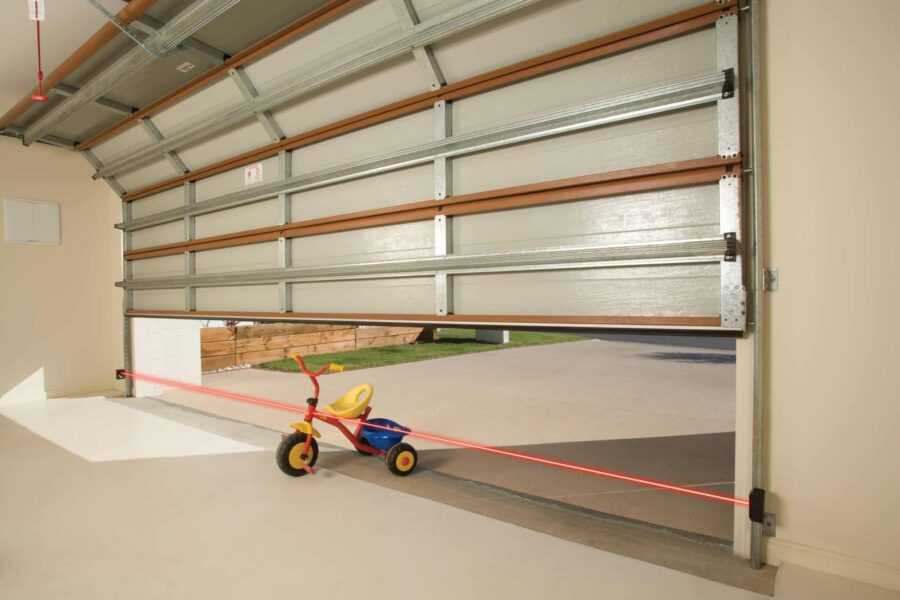
1. Regular Cleaning
Dust, dirt, and debris can accumulate on the sensors over time, potentially obstructing the beam of light. Cleaning the sensors regularly helps maintain their functionality. Use a soft, dry cloth to wipe the lenses gently. Avoid using harsh chemicals or abrasive materials, as these can damage the sensors.
2. Checking Alignment
Proper alignment is crucial for the sensors to work correctly. Misaligned sensors may fail to detect obstructions, rendering the safety feature ineffective. To check the alignment:
- Inspect the sensors to ensure they are mounted at the same height on both sides of the garage door.
- Look for indicator lights on the sensors. Most sensors have lights that show whether they are aligned properly. A solid light usually indicates correct alignment, while a blinking or off light suggests misalignment.
- Adjust the sensors if necessary by loosening the mounting brackets and gently repositioning them until the lights indicate proper alignment.
3. Testing the Sensors
Regularly testing the sensors ensures they are functioning correctly. Here’s how to perform a simple test:
- Close the garage door: Use the garage door opener to close the door.
- Block the sensor: While the door is closing, wave an object (like a broomstick) in front of one of the sensors to break the beam.
- Observe the door’s response: The door should stop and reverse direction. If it doesn’t, the sensors may need cleaning, realignment, or replacement.
Perform this test at least once a month to ensure the sensors are working as intended.
4. Inspecting Wiring and Connections
Over time, the wiring and connections of the sensors can become loose or damaged. Regularly inspect these components to ensure they are secure and in good condition. Look for signs of wear, fraying, or damage to the wires. If any issues are found, consult the garage door opener’s manual or a professional technician for guidance on repairs or replacements.
5. Ensuring Proper Installation
Correct installation is fundamental for the sensors to function properly. If the sensors were installed incorrectly, they might not work as intended. Ensure the sensors are installed:
- At the appropriate height (usually 6 inches above the floor).
- Firmly mounted with no loose parts.
- With a clear path between them, free of any obstacles.
If you are unsure about the installation, consider consulting a professional for an assessment.
6. Protecting Sensors from Damage
Garage environments can be harsh, with various activities that might accidentally damage the sensors. Take steps to protect them:
- Avoid placing heavy objects or tools near the sensors.
- Be cautious when performing activities like sweeping or moving items in the garage to prevent hitting the sensors.
- Consider installing protective covers or guards around the sensors to shield them from accidental impacts.
7. Seasonal Maintenance
Different seasons can affect the performance of garage door sensors. For instance:
- Winter: Cold weather can cause condensation and ice buildup on the sensors. Regularly check and clean the sensors during winter months.
- Spring/Summer: Increased dust and pollen can accumulate on the sensors. Clean them more frequently during these seasons.
- Fall: Falling leaves and debris can obstruct the sensors. Ensure the area around the sensors is kept clear.
Adapting your maintenance routine to the changing seasons helps maintain the sensors’ functionality year-round.
8. Professional Inspections
While regular DIY maintenance is essential, professional inspections can provide a thorough assessment of your garage door system. A trained technician can identify potential issues that may not be apparent to the untrained eye. Consider scheduling professional inspections annually or biannually to ensure your sensors and overall garage door system are in optimal condition.
Troubleshooting Common Issues
Despite regular maintenance, issues with garage door safety sensors can still arise. Here are some common problems and troubleshooting tips:
- Sensor Lights Are Off: This could indicate a power issue. Check the wiring and connections to ensure the sensors are receiving power. If the problem persists, consult a professional.
- Blinking Sensor Lights: Blinking lights typically indicate misalignment. Follow the steps mentioned earlier to realign the sensors.
- Intermittent Operation: If the sensors work sporadically, this might be due to loose connections or environmental factors like direct sunlight interference. Inspect the connections and consider installing sun shields if necessary.
- Door Closes Despite Obstruction: This is a serious issue that requires immediate attention. Clean the sensors, check the alignment, and test the system. If the problem persists, disconnect the garage door opener and contact a professional technician.
Why Professional Help is Essential
While some homeowners may feel capable of handling garage door sensor installation and maintenance themselves, professional help is often the safest and most efficient option. Incorrect installation or maintenance can lead to safety risks and potential damage to the garage door system. Professional technicians are trained and equipped to ensure that safety sensors are installed and maintained correctly, providing peace of mind and ensuring the safety of your home or business.
Conclusion
Garage door safety sensors are a vital component of modern garage door systems, significantly enhancing safety by preventing accidents and damage. Proper installation and regular maintenance of these sensors are crucial. By following the guidelines outlined in this article and seeking professional assistance when necessary, homeowners and business owners in Australia can ensure their garage doors operate safely and efficiently.

